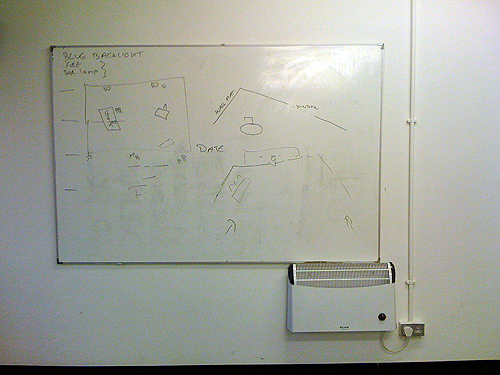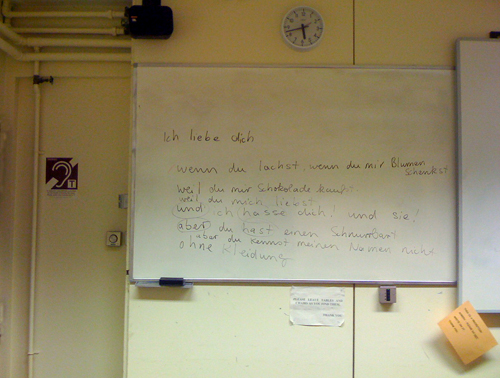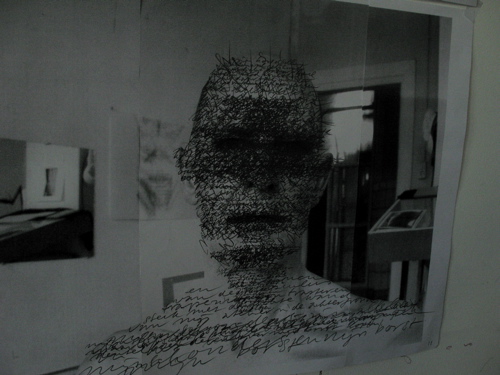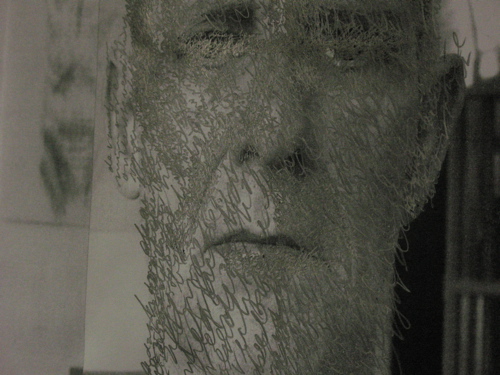Saturday I was sitting for the portrait by Toine Horvers which I mentioned already here. The task at this point was for him to get a photograph that will be the basis of the picture and at the same time for me to describe my face more or less as it appears in the same light and situation, generating text that will the be written over and layer the image. Getting the photograph was simple enough – 12 shots in natural light, straight to camera. Once it was done I spent 30-45 minutes sat in the same place – in the open doorway of Hugo’s studio (best light in the neighborhood) – staring at my reflection in a mirror on a music stand that trembled now and then in the breeze. I wrote fast as much as I could, (it was cold and I was half naked), and didn’t allow myself to revise or re-structure. I found the work pretty hard – in a good way – realising again and again that I didn’t have the skills (or the right kind of visual or mental organisation?) to be methodical in the task – and guessing that Toine, trained in life class drawing, or photographers Hugo or Tamar (who took the picture) – would likely have made a much more systematic and clear job of it all. Started to think too, that in my whole written output since the age of 20 or whatever there’s probably never been a single detailed description of a face anywhere – probably few descriptions of faces at all. Trying to figure out what that might mean and guessing that it might be something to do with how seriously I’m taking my fictional propositions. Below there’s a chunk of what I wrote on Saturday. In Toine’s final work this (and the rest of it) will get written across the picture, comments on specific parts or areas of the face written specifically onto or over them, the general description or phrases written bold and all over… a kind of mapping the text to its subject that produces the kinds of concentrations, obliterations, spaces and re-emphases that the tests already show.
…stray hairs on the top of the forehead. Like trees, isolated trees sticking up out of floodwater. The place where the hair of the sideburns meets the beard on the right (as I look at it) is where the mix of colours is most intense – white, ginger brown, grey. Slight pink of the cheeks. Thick heavy shadow in the corners below the mouth. A burst of white on the right corner of the chin. Points of light in the eyes. The hair of the beard moving upwards onto the cheeks, thinning out, individual hairs visible – white grey black. Too many to count? Probably, A spot in the middle of the chin itself here where seems to be no hair. Smiling changes everything. Suddenly there are new lines that go from the corners of the eyes to the edges of the face. Three or four lines going upwards, more going downwards. The lines filled with shadow. Lines from the corners of the nose, reaching down to the mouth. Lines under the eyes, layers of shadow under the eyes. Dispersed blemishes – a tiny faint spot to the right side of the nose. Above it to the right another even fainter spot. On the other side a larger spot, not discoloured, just more like circle of raised skin. A strange line almost following the cheekbone (but higher) on the right-hand side. Worried again that I am losing track of left and right, then laughing about it, which produces new lines, movements, shifts the shadows. Filling into the detail of my face, I am completely unable to make any kind of consistent orientation. Eyes scanning it. No sooner that I started on describing one thing I already lost interest in it and found something else. Eyes again. A sudden stillness where you think, for no reason, now I am here. Ears. Sea shell curves and shadows. High points of light. The Guggenheim. Eyes. The number of times I sat in front of the camera in the daylight of the widow of my own bedroom for some video or another. Only there always talking or thinking. And here writing. The tensing and relaxing of the muscles under the eyes. Swallowing animates the neck. There is the biopsy scar on the left side of the neck. Hairline crack in the skin. To the base of that scar, where it curves to the Adam’s apple you can still see the smaller lines left by each of the stitches. There, just above that is the blue/purple mark, the small indentation which Vlatka always called hers and which the surgery in 2004 – the biopsy or the sternotomy I can’t remember – basically destroyed, knotting it into scar tissue. But then, a year or more later it returned. The difference between the first hairs of the chest – wispy, vague, tangled and the lowest hairs of the beard (the ones that spill down the neck). The scar like a railway track snaking across, a ridge that catches the light, going nowhere. In the centre of the chest, leading up to it I can just see the thicker scar from the sternotomy – the drawn purple line that divides me. And left of that at the shoulder, the mess made by numerous pacemaker operations. A single similar scar at the right – that strange white skin of scar, again the stitches. A tangle of scars – plus some hairs, some discoloured skin. Face moving a lot now because I am laughing because I have the sudden idea I am describing a monster. Wondering if every face described would be this way once looked at in detail. No, definitely not. Softer light now. Kinder. And my face relaxed. Unable to keep its public shape, its camera shape, too long. Or aware that it is dissolving in any case by virtue of this disorganised description. Aware that I am not sticking to the facts. But not sure what the facts are. Smoother forehead now, but still marked by 5 lines…



